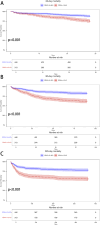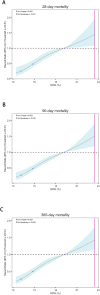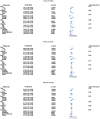Association of red blood cell distribution width with short- and long-term all-cause mortality in patients with acute pancreatitis and sepsis
- PMID: 40731314
- PMCID: PMC12309111
- DOI: 10.1186/s12876-025-04167-5
Association of red blood cell distribution width with short- and long-term all-cause mortality in patients with acute pancreatitis and sepsis
Abstract
Background: The association between red blood cell distribution width (RDW) and short- and long-term all-cause mortality in patients with acute pancreatitis (AP) and sepsis remains unclear.
Methods: Data were extracted from the MIMIC-IV database for patients diagnosed with AP and sepsis. The primary research endpoints were all-cause mortality at 28, 90, and 365 days. Kaplan-Meier survival curve analysis, restricted cubic spline (RCS) receiver operating characteristic (ROC) curves, subgroup analysis, and Cox regression were employed to assess the association between RDW and mortality.
Results: A total of 759 patients with AP and sepsis were included. The all-cause mortality rates were 17.26%, 25.96%, and 31.49% at 28, 90, and 365 days, respectively. Cox regression analysis indicated that, after adjustment for covariates, elevated RDW was significantly associated with increased risk of mortality at 28, 90, and 365 days. The hazard ratios (HR) were 1.08 (95% CI: 1.02-1.14) for 28-day mortality, 1.12 (95% CI: 1.07-1.17) for 90-day mortality, and 1.13 (95% CI: 1.08-1.18) for 365-day mortality. The RCS analysis indicated a nonlinear relationship. Kaplan-Meier analysis demonstrated significantly higher mortality in the high-RDW group compared to the low-RDW group (p < 0.001). The area under the curve (AUC) for RDW was greater than that for BISAP and SIRS, but lower than the SOFA. Subgroup analyses showed no significant interactions between RDW and most subgroups.
Conclusion: Elevated RDW is independently associated with increased short- and long-term all-cause mortality in patients with AP and sepsis.
Keywords: Acute pancreatitis; All-cause mortality; MIMIC-IV.; Red blood cell distribution width; Sepsis.
© 2025. The Author(s).
Conflict of interest statement
Declarations. Ethics approval and consent to participate: This study was conducted in accordance with Good Clinical Practice (Declaration of Helsinki 2002). The data was extracted from Medical Information Mart for Intensive Care IV (MIMIC-IV, Version 3.1). All personal information has been removed, and the identity of the patient has been replaced by a random number. Thus, there were no additional consent procedures from the institutional ethics committee. Consent for publication: Not applicable. Competing interests: The authors declare no competing interests.
Figures





Similar articles
-
The Predictive Value of Red Cell Distribution Width for the Risk of Sepsis in Patients with Acute Pancreatitis: A Retrospective Cohort Study.Pancreas. 2025 Jul 1;54(6):e562-e570. doi: 10.1097/MPA.0000000000002475. Pancreas. 2025. PMID: 39937875
-
Higher red cell distribution width (RDW) is associated with increased all-cause and cardiovascular mortality in patients with breast cancer: A retrospective analysis of NHANES data (1999-2018).PLoS One. 2025 Jul 28;20(7):e0328680. doi: 10.1371/journal.pone.0328680. eCollection 2025. PLoS One. 2025. PMID: 40720508 Free PMC article.
-
Prognostic value of red cell distribution width-to-albumin ratio in septic patients with malignancies: A retrospective cohort study based on the MIMIC-IV database.Sci Prog. 2025 Jul-Sep;108(3):368504251370990. doi: 10.1177/00368504251370990. Epub 2025 Aug 19. Sci Prog. 2025. PMID: 40827332 Free PMC article.
-
Sex as a prognostic factor for mortality in adults with acute symptomatic pulmonary embolism.Cochrane Database Syst Rev. 2025 Mar 20;3(3):CD013835. doi: 10.1002/14651858.CD013835.pub2. Cochrane Database Syst Rev. 2025. PMID: 40110896
-
Sertindole for schizophrenia.Cochrane Database Syst Rev. 2005 Jul 20;2005(3):CD001715. doi: 10.1002/14651858.CD001715.pub2. Cochrane Database Syst Rev. 2005. PMID: 16034864 Free PMC article.
References
-
- Iannuzzi JP, King JA, Leong JH, Quan J, Windsor JW, Tanyingoh D, et al. Global incidence of acute pancreatitis is increasing over time: A systematic review and Meta-Analysis. Gastroenterology. 2022;162:122–34. - PubMed
-
- Mederos MA, Reber HA, Girgis MD. Acute pancreatitis: A review. JAMA. 2021;325:382–90. - PubMed
-
- Werner J, Bernhard P, Cosenza-Contreras M, Pinter N, Fahrner M, Pallavi P, et al. Targeted and explorative profiling of Kallikrein proteases and global proteome biology of pancreatic ductal adenocarcinoma, chronic pancreatitis, and normal pancreas highlights disease-specific proteome remodelling. Neoplasia. 2023;36:100871. - PMC - PubMed
-
- Griesbacher T. Kallikrein-kinin system in acute pancreatitis: potential of B(2)-bradykinin antagonists and Kallikrein inhibitors. Pharmacology. 2000;60:113–20. - PubMed
MeSH terms
LinkOut - more resources
Full Text Sources
Medical

